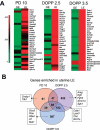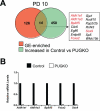Cell-specific transcriptional profiling reveals candidate mechanisms regulating development and function of uterine epithelia in mice
- PMID: 23946541
- PMCID: PMC7289334
- DOI: 10.1095/biolreprod.113.111971
Cell-specific transcriptional profiling reveals candidate mechanisms regulating development and function of uterine epithelia in mice
Abstract
All mammalian uteri have luminal (LE) and glandular epithelia (GE) in their endometrium. The LE mediates uterine receptivity and blastocyst attachment for implantation, and the GE synthesize and secrete or transport bioactive substances involved in blastocyst implantation, uterine receptivity, and stromal cell decidualization. However, the mechanisms governing uterine epithelial development after birth and their function in the adult are not fully understood. Here, comprehensive microarray analysis was conducted on LE and GE isolated by laser capture microdissection from uteri on Postnatal Day 10 (PD 10) and day of pseudopregnancy (DOPP) 2.5 and 3.5. This data was integrated with analysis of uteri from gland-containing control and aglandular progesterone-induced uterine gland knockout mice from PD 10 and DOPP 3.5. Many genes were expressed in both epithelia, but there was greater expression of genes in the LE than in the GE. In the neonate, GE-expressed genes were enriched for morphogenesis, development, migration, and retinoic acid signaling. In the adult, LE-expressed genes were enriched for metabolic processes and steroid biosynthesis, whereas retinoid signaling, tight junction, extracellular matrix, and regulation of kinase activity were enriched in the GE. The transcriptome differences in the epithelia support the idea that each cell type has a distinct and complementary function in the uterus. The candidate genes and regulatory networks identified here provide a framework to discover new mechanisms regulating development of epithelia in the postnatal uterus and their functions in early pregnancy.
Keywords: endometrium; gene expression; guinea pigs; implantation; mice; rodents (rats; uterus; voles).
Figures





Similar articles
-
Endometrial glands are essential for blastocyst implantation and decidualization in the mouse uterus.Biol Reprod. 2013 Apr 11;88(4):93. doi: 10.1095/biolreprod.113.107631. Print 2013 Apr. Biol Reprod. 2013. PMID: 23407384
-
Temporal expression profiling of the uterine luminal epithelium of the pseudo-pregnant mouse suggests receptivity to the fertilized egg is associated with complex transcriptional changes.Hum Reprod. 2006 Oct;21(10):2495-513. doi: 10.1093/humrep/del195. Epub 2006 Jun 21. Hum Reprod. 2006. PMID: 16790611
-
Mechanisms regulating norgestomet inhibition of endometrial gland morphogenesis in the neonatal ovine uterus.Mol Reprod Dev. 2000 Sep;57(1):67-78. doi: 10.1002/1098-2795(200009)57:1<67::AID-MRD10>3.0.CO;2-M. Mol Reprod Dev. 2000. PMID: 10954858
-
Biology of progesterone action during pregnancy recognition and maintenance of pregnancy.Front Biosci. 2002 Sep 1;7:d1879-98. doi: 10.2741/spencer. Front Biosci. 2002. PMID: 12161340 Review.
-
Uterine glands: biological roles in conceptus implantation, uterine receptivity and decidualization.Int J Dev Biol. 2014;58(2-4):107-16. doi: 10.1387/ijdb.130344ts. Int J Dev Biol. 2014. PMID: 25023676 Free PMC article. Review.
Cited by
-
Distinguish Characters of Luminal and Glandular Epithelium from Mouse Uterus Using a Novel Enzyme-Based Separation Method.Reprod Sci. 2023 Jun;30(6):1867-1877. doi: 10.1007/s43032-022-01154-z. Epub 2022 Dec 29. Reprod Sci. 2023. PMID: 36581776
-
A Role for Androgens in Epithelial Proliferation and Formation of Glands in the Mouse Uterus.Endocrinology. 2016 May;157(5):2116-28. doi: 10.1210/en.2015-2032. Epub 2016 Mar 10. Endocrinology. 2016. PMID: 26963473 Free PMC article.
-
Generation of Mouse for Conditional Expression of Forkhead Box A2.Endocrinology. 2018 Apr 1;159(4):1897-1909. doi: 10.1210/en.2018-00158. Endocrinology. 2018. PMID: 29546371 Free PMC article.
-
Uterine glands impact uterine receptivity, luminal fluid homeostasis and blastocyst implantation.Sci Rep. 2016 Dec 1;6:38078. doi: 10.1038/srep38078. Sci Rep. 2016. PMID: 27905495 Free PMC article.
-
Reconstructing Lineage Hierarchies of Mouse Uterus Epithelial Development Using Single-Cell Analysis.Stem Cell Reports. 2017 Jul 11;9(1):381-396. doi: 10.1016/j.stemcr.2017.05.022. Epub 2017 Jun 15. Stem Cell Reports. 2017. PMID: 28625536 Free PMC article.
References
-
- Brody JR,Cunha GR.. Histologic, morphometric, and immunocytochemical analysis of myometrial development in rats and mice: I. Normal development.Am J Anat 1989;186:1–20. - PubMed
-
- Bartol FF,Wiley AA,Floyd JG,Ott TL,Bazer FW,Gray CA,Spencer TE.. Uterine differentiation as a foundation for subsequent fertility.J Reprod Fertil Suppl 1999;54:287–302. - PubMed
-
- Hu J,Gray CA,Spencer TE.. Gene expression profiling of neonatal mouse uterine development.Biol Reprod 2004;70:1870–1876. - PubMed
-
- Branham WS,Sheehan DM,Zehr DR,Ridlon E,Nelson CJ.. The postnatal ontogeny of rat uterine glands and age-related effects of 17 beta-estradiol.Endocrinology 1985;117:2229–2237. - PubMed
-
- Spencer TE,Dunlap KA,Filant J.. Comparative developmental biology of the uterus: insights into mechanisms and developmental disruption.Mol Cell Endocrinol 2012;354:34–53. - PubMed
Publication types
MeSH terms
Substances
Grants and funding
LinkOut - more resources
Full Text Sources
Other Literature Sources
Medical
Molecular Biology Databases

